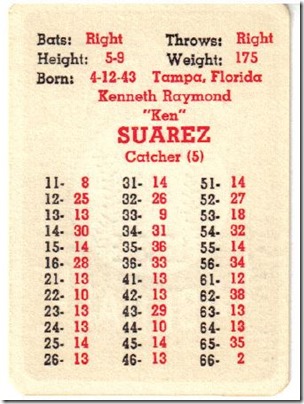Scott Veatch came through with this very interesting Ken Suarez card from the original 1966 set.
Rookie catcher Suarez played for the Kansas City Athletics and actually started 26 games for them. Batting .145, his only extra base hit was a triple. He did walk fifteen times so his OBP (.298) was nearly double of his batting average.
Incidentally, he also stole two bases.
| Split | G | GS | PA | AB | R | H | 2B | 3B | HR | RBI | SB | BB | SO | |||
|---|---|---|---|---|---|---|---|---|---|---|---|---|---|---|---|---|
| 1966 Totals | 35 | 26 | 85 | 69 | 5 | 10 | 0 | 1 | 0 | 2 | 2 | 15 | 26 | .145 | .298 | .174 |
Of all the “Weird” cards I’ve done, Suarez’ has the most quantitative oddities starting with the singular first column 2. And let’s face it, that 66-2 was a gift. With one triple in 85 plate appearances, he will probably hit two. However, that brings up a good question, is APBA wrong in this? Probably not. If played realistically, this might mean one extra triple in a full replay. Hardly worth getting too worked up over.
Second, he appropriately has five six 14s compared to the five total hit numbers on his card. All told, he has hit numbers 2-8-9-10-10.
But strangest of all is the placement of Ken Suarez’ 10s. Instead of placing them at 15 and 25 where we would expect them, APBA put them at 22 and 44. He has 14s where you would expect his steal numbers. My educated guess is that APBA felt awkward about putting a non-hit number (a 14) at 22 for a non-pitcher. Again, just a guess.
Considering his playing time, Suarez’ 1966 card isn’t that bad despite his .145 batting average and even his .298 on-base percentage (not to mention his C-5 fielding rating).
Here’s why I say this:
To gauge hitters, I like to count the numbers that get on base against an A pitcher. It’s a habit I picked up probably reading an APBA Journal article from years gone by. Suarez’ card has a 2, two 10s and five six 14s for a total of eight nine. In my experience, that’s average to good if you discount power. To give you some perspective, 2013 Albert Pujols has just seven on base numbers against an A pitcher and 2013 Jose Reyes has eight. That probably tells you the emphasis that APBA places on offensive walks more than anything.
Of course, Suarez’ card probably won’t hit any homers and he really won’t get many hits at all. Admittedly, his offensive value is just getting on base… when he actually plays.
As some of you know, I’m in the middle of replaying the 1966 NL right now. I’ll have to dig up the KC Athletics since I’m using the reprint version of the 1966 set and see how APBA worked up Suarez’ card the second time around.
thanks again Scott!





I count 6 14s.
yeah, you’re right, Steve.
Hard to count them when they’re in strange places. I think I missed the 55-14.
it’s been fixed. thanks!